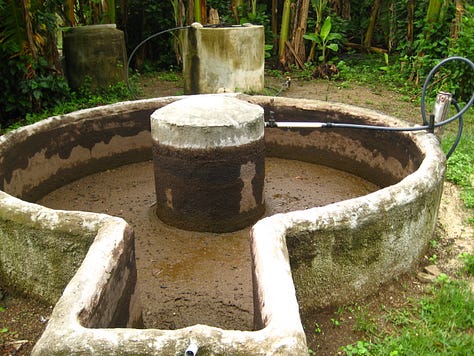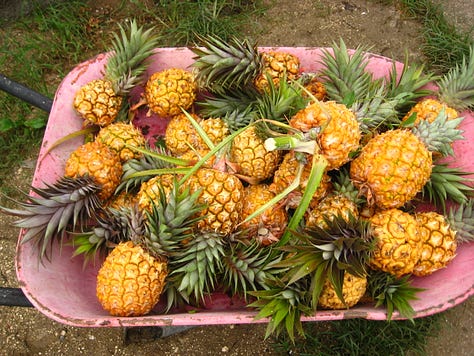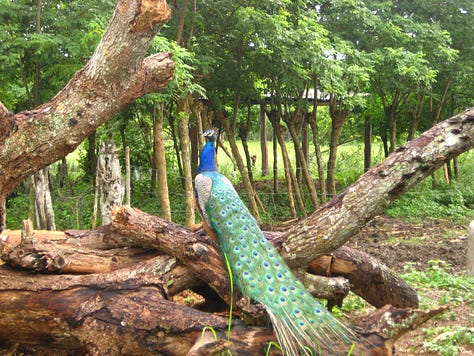An old letter from Sancti Spíritus
A short essay composed in 2013 about Cuban agroecology from the deep archives
In 2013, I visited some Cuban farms to report on if and how the country’s renowned agroecological production might be altered by a slow slip into the market economy. While I was there, I visited one of the more famous agroecological lighthouse farms. I was so impressed by the full power of agroecology on display that I composed a small piece that I was told to be published in a science communication series as part of a statewide news outlet. They never ran the series and I never followed through with shopping it around to a different publisher.
I was looking for pictures of the visit for a talk I am preparing and I stumbled upon the piece. In one way the essay is indicative that I’m still working on the same main research theme: Agroecology provides a clear alternative to problems of the industrial and corporate food system. This is true even while eco-modernists pursue a “flight forward” to some kind of super efficiency through precision techniques and technology enabled productivity. What is holding agroecology back?
On the other hand the letter reveals an older weakness to my analysis. It suggests that if research and storytelling can show how the techniques of agroecology are superior—for ecology, for livelihoods, for the climate—then powerful actors will take them up. This is the everlasting, but harmful “knowledge deficit” approach in full force.
We should be enamored (as I was) by the observed harmonious potential of agroecology. But there is an overvaluing of the technocratic aspects of alternative agriculture. Prairie strips, hedgerows, mobile chicken coops, drone mediated pest management, robot strawberry harvesters … the list goes on. For an alternative food system to survive and scale, we have to be more critical about the reasons that good techniques are not politically favored. This is the lesson this unearthed dispatch from Cuba and my older more naïve self confirms.
On to the essay from 2013:
Cuba’s lessons for the future of agriculture






The message from the United Nations Food and Agriculture Organization is clear: A 2009 report calls for a 70% increase in global food production in order to feed the projected 9.1 billion people by the year 2050. The Gates Foundation has responded to this need, paying out $264.5 million to date in grant funds towards a new “Green Revolution” in select African nations.
Before falling in with the “feed the world argument”, I wanted to visit an agricultural system that demonstrated impressive yields, but bore little resemblance to the dominant industrial farming model: not dependent on agrochemicals, bioengineered crops, or modern technology. I needed to go to Cuba, where a US trade embargo and collapse of the Soviet bloc forced a limited availability of imported agricultural machinery and petrochemicals.
I had read about a Cuban farm in Agronomy for Sustainable Development that was producing enough calories and protein to fulfill the nutritional needs of 20 people per year, but operated on 10 hectares of land. I decided to see for myself what agricultural practices were being used at this farm, and in turn what alternative visions food production might look like, even as the Gates Foundation and their allies were promoting their high-modernist approach.
When I first arrived at Camilo’s farm, outside the town of Sancti Spíritus, I was greeted in the kitchen, which was also the garage for a red ’64 Jawa motorcycle.
“You look out over my farm and you see disorder. But not me,” Camilo said. “Have you heard of Bill Mollison, the founding father of permaculture? He says in the apparent disorder of nature true order can be found.” He offered to show me around for a few days, while I tried to break down the farm into its ecological components.
Camilo’s farm, at its core, is a rotational grazing system, where 16 cows occupy certain parcels during the year, eating grass and fertilizing the field, while other fenced off paddocks are devoted to intensive vegetable and fruit production. These systems are sometimes called silvo-pastoral, indicating the integration of ruminants with valuable tree species. All of Camilo’s fencing is live, consisting of trees that either provide fruit for his family, fodder for his cows, or legumes that fix nitrogen in the soil. Barbwire, a usual fixture of pasture in the world was notably hard to spot. His fruit and vegetable production is an intensive polyculture of 35 different crops including root crops like boniato, three different types of squash, coffee and peppers.
Peacocks, first brought on as an experiment, were part of his system to deter pests. After observing them for a time, Camilo noticed they prefer to eat only the pest insects, leaving beneficial predators like parasitoid wasps alone. “The goal is to live in a forest, but a productive forest,” he said. Biodiversity, he mentioned, is the only tool he needs to deal with pests; his farm uses no pesticides.
This concept, the blend of biodiversity and agriculture referred to as ‘agri-biodiversity’, has received increasing attention among researchers and is thought of as achieving the dual goal of providing beneficial agricultural services, like pollination and pest management, as well as habitat for other species.
At 5am the following day we were milking the cows under an open-air wood and tin enclosure. His daughter appeared with a shovel and solicited my help in shoveling all of the excrement into an old wheelbarrow, which was about the only farm task I could perform with a degree of competency. We carried a nights worth of droppings over to a series of concrete tanks, known to the field of environmental engineering as a bio-digester.
The excrement collects in the tank and ferments – killing pathogens and producing methane. The gas is collected for cooking and heating and the effluent he puts back onto his field as nutrient rich, disease free fertilizer. For his main commodity crop, 1500 banana trees that provide 2-3 harvests per year, he adds up to 10 liters of the fertilizer each time he starts a new plant. He also adds the remaining effluent along with food waste to fuel a worm compost bin, of which the castings provide an additional source of soil nutrients. “My best employees,” he said.
“When you see the excrement of a cow, as fertilizer, as fruit, as food, then it is not shit, it is not excrement, it is something else. When you view it as energy to cook with or food for your worms, then you can see a cow shitting, as they say here in Cuba, it’s no longer shitting . . . it is offering.”
At first glance, Camilo’s farm might seem like the exception, not the rule. But, like Camilo, there are over 100,000 producers that are part of the National Association of Small Farmers in Cuba, the organization that helped teach Camilo some of the practices he now masters. Also, the idea of small, diversified farms “feeding the world” is gaining traction in arenas previously aligned otherwise. A September 2013 United Nations Conference on Trade and Development report urges that the current model of industrial agriculture is only leading to more hunger and degraded ecosystems. Their final recommendation of how to shift our agricultural system? Support mosaics of diverse smallholder production.




